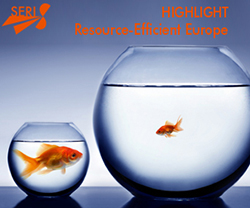Global Resource Accounting Model (GRAM)
A global model to calculate the ecological rucksacks of international trade.
The Global Resource Accounting Model (GRAM) was first developed in the course of the international research project petrE. GRAM was constructed to illustrate the physical dimension of Europe’s economic interrelations with the rest of the world and to analyse European natural resource consumption and trade in a global perspective. The GRAM model disaggregates 52 countries and world regions, represented with so-called input-output tables of 48 economic sectors and linked by bilateral trade flows in 25 product groups and 1 service sector. The model integrates the latest (2006) edition of input-output tables published by the OECD with the OECD’s Bilateral Trade Database and is extended by a global database on resource extraction in all countries of the world (see www.materialflows.net).
GRAM allows
• calculating aggregated indicators on material extraction versus consumption of countries and world regions,
• assessing international trade flows to identify main net-importers and net-exporters of different categories of natural resources in the world economy.
• disaggregating results in terms of economic sectors and types of materials to identify most resource-intensive economic sectors and product groups.
Key results
Using the Global Resource Accounting Model we showed that the EU has higher net imports of natural resources than any other single country in the world economy. Its material consumption by far exceeds its domestic resources, and a significant and growing share of EU’s consumption is met by natural resources from other world regions.
The results underline that a country’s resource efficiency alone is not a suitable indicator for its environmental sustainability. It needs to be complemented by data on the total amounts of extraction and consumption, as countries with the highest resource efficiency in the world are in most cases also the ones which extract and consume the highest amounts per capita (notably Europe and North America).
Publications
Giljum, S., Lutz, C., Jungnitz, A. 2008. The Global Resource Accounting Model (GRAM). A methodological concept paper. SERI Studies No 8. Sustainable Europe Research Institute. Vienna. Download.
Giljum, S., Lutz., C., Jungnitz, A., Bruckner, M., Hinterberger, F. 2008. Global dimensions of European natural resource use. Results from the Global Resource Accounting Model (GRAM). Paper presented to the OECD/UNEP Conference on Resource Efficiency. Paris. Download.
Contact
Project partners
- GWS, Osnabrück

